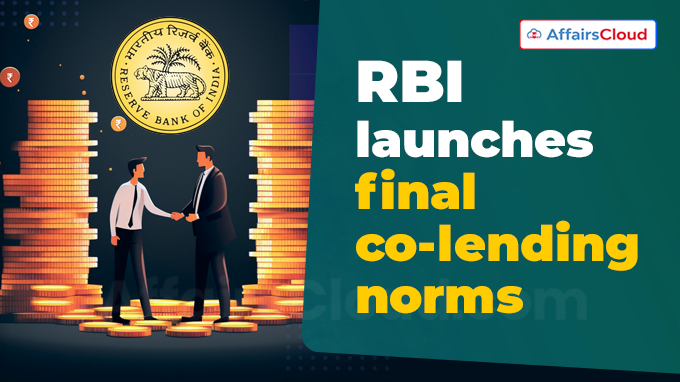
In August 2025, the Reserve Bank of India (RBI) issued revised co-lending guidelines for banks and Non-Bank Financial Companies (NBFCs) under various provisions of the Banking Regulation Act (1949), Reserve Bank of India Act (1934), and National Housing Bank Act (1987). As per the revised guidelines, it is now mandatory for all Regulated Entities (REs) involved in Co-lending Arrangements (CLAs) to retain a minimum 10% of each individual loan on their own books.
- RBI has also clarified that digital lending arrangements will continue to be administered by the ‘Reserve Bank of India (Digital Lending) Directions, 2025’.
- These revised guidelines will come into force from January 01, 2026.
Exam Hints:
- What? Launch of final co-lending guidelines for Banks and NBFCs
- Launched by: RBI
- Effective From: January 01, 2026
- Minimum rate of Individual Loan: 10%
- Applicable to: Commercial banks (excluding: SFBs, Regional Rural Banks, RRBs, and LABs), financial institutions, and NBFCs including HFCs
- Deadline: 15 days
- Maximum DLG: 5%
Key Provisions:
Timeline: The new rules mandated the loan originator to transfer the loan to the co-lender within 15 days of the loan being originated.
- In case of failure to adhere to the timeline specified in the rules, the loan will no longer be considered a CLA and can then only be transferred to other eligible lenders according to the provisions under Transfer of Loan Exposure norms of 2021.
Maximum DLG: As per the new rules, the originating lender may also offer maximum Default Loss Guarantee (DLG) of 5% of the outstanding loan portfolio, subject to the condition to comply with RBI’s digital lending norms and is not used for credit enhancement.
PSL: Each partner in the co-lending arrangement can classify its portion of the loan as Priority Sector Lending (PSL), provided the loan meets PSL eligibility criteria.
Applicability: RBI’s approved final norms for CLA have been extended to all commercial banks (excluding: Small Finance Banks (SFBs), Regional Rural Banks (RRBs), and Local Area Banks (LABs), financial institutions, and NBFCs including Housing Finance Companies (HFCs).
Blended Interest Rate: RBI has mentioned that the interest rate charged to borrowers will be a blended rate, which will be determined based on the weighted average of each RE’s internal rate, proportionate to their funding contribution.
Uniform Asset Classification: The new CLA rules has introduced a uniform asset classification system which means if one lender classifies a loan as a Special Mention Account (SMA) or Non-Performing Asset (NPA), then the same classification will be applicable to the co-lending partner for their exposure to that borrower.
Provisions to include in Co-Lending: Lenders have been mandated to include certain provision like: the criteria for borrower selection, product lines, geographical areas of operation, fee structures, and other relevant terms, for co-lending in their credit policies.
Other key features: As per revised norms, the loan arrangement with the borrower is required to add an upfront disclosure of the roles and responsibilities of each partner.
- In addition to that, all transactions including disbursements and repayments between REs and with the borrower must be done through an escrow account maintained with a bank.
Recent Related News:
In July 2025, RBI granted Scheduled Bank (SB) status to NSDL Payments Bank Limited, a subsidiary of National Securities Depository Limited (NSDL), in exercise of its powers given under Section 42(6) (a) of the RBI Act, 1934.
- NSDL Payments Bank Ltd. has been placed in Schedule II of the RBI Act, 1934.




